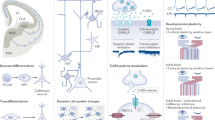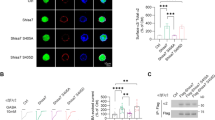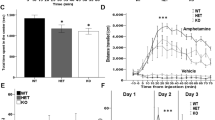Abstract
Mutations in the X-linked MECP2 gene, which encodes the transcriptional regulator methyl-CpG-binding protein 2 (MeCP2), cause Rett syndrome and several neurodevelopmental disorders including cognitive disorders, autism, juvenile-onset schizophrenia and encephalopathy with early lethality. Rett syndrome is characterized by apparently normal early development followed by regression, motor abnormalities, seizures and features of autism, especially stereotyped behaviours. The mechanisms mediating these features are poorly understood. Here we show that mice lacking Mecp2 from GABA (γ-aminobutyric acid)-releasing neurons recapitulate numerous Rett syndrome and autistic features, including repetitive behaviours. Loss of MeCP2 from a subset of forebrain GABAergic neurons also recapitulates many features of Rett syndrome. MeCP2-deficient GABAergic neurons show reduced inhibitory quantal size, consistent with a presynaptic reduction in glutamic acid decarboxylase 1 (Gad1) and glutamic acid decarboxylase 2 (Gad2) levels, and GABA immunoreactivity. These data demonstrate that MeCP2 is critical for normal function of GABA-releasing neurons and that subtle dysfunction of GABAergic neurons contributes to numerous neuropsychiatric phenotypes.
This is a preview of subscription content, access via your institution
Access options
Subscribe to this journal
Receive 51 print issues and online access
$199.00 per year
only $3.90 per issue
Buy this article
- Purchase on Springer Link
- Instant access to full article PDF
Prices may be subject to local taxes which are calculated during checkout





Similar content being viewed by others
References
Chahrour, M. & Zoghbi, H. Y. The story of Rett syndrome: from clinic to neurobiology. Neuron 56, 422–437 (2007)
Lam, C. W. et al. Spectrum of mutations in the MECP2 gene in patients with infantile autism and Rett syndrome. J. Med. Genet. 37, e41 (2000)
Klauck, S. M. et al. A mutation hot spot for nonspecific X-linked mental retardation in the MECP2 gene causes the PPM-X syndrome. Am. J. Hum. Genet. 70, 1034–1037 (2002)
Cohen, D. et al. MECP2 mutation in a boy with language disorder and schizophrenia. Am. J. Psychiatry 159, 148–149 (2002)
Carney, R. M. et al. Identification of MeCP2 mutations in a series of females with autistic disorder. Pediatr. Neurol. 28, 205–211 (2003)
Amir, R. E. et al. Rett syndrome is caused by mutations in X-linked MECP2, encoding methyl-CpG-binding protein 2. Nature Genet. 23, 185–188 (1999)
Hagberg, B., Aicardi, J., Dias, K. & Ramos, O. A progressive syndrome of autism, dementia, ataxia, and loss of purposeful hand use in girls: Rett’s syndrome: report of 35 cases. Ann. Neurol. 14, 471–479 (1983)
Weese-Mayer, D. E. et al. Autonomic nervous system dysregulation: breathing and heart rate perturbation during wakefulness in young girls with Rett syndrome. Pediatr. Res. 60, 443–449 (2006)
Weese-Mayer, D. E. et al. Autonomic dysregulation in young girls with Rett syndrome during nighttime in-home recordings. Pediatr. Pulmonol. 43, 1045–1060 (2008)
Deidrick, K. M., Percy, A. K., Schanen, N. C., Mamounas, L. & Maria, B. L. Rett syndrome: pathogenesis, diagnosis, strategies, therapies, and future research directions. J. Child Neurol. 20, 708–717 (2005)
Jedele, K. B. The overlapping spectrum of Rett and Angelman syndromes: a clinical review. Semin. Pediatr. Neurol. 14, 108–117 (2007)
Hagberg, B. Clinical manifestations and stages of Rett syndrome. Ment. Retard. Dev. Disabil. Res. Rev. 8, 61–65 (2002)
Neul, J. L. et al. Specific mutations in methyl-CpG-binding protein 2 confer different severity in Rett syndrome. Neurology 70, 1313–1321 (2008)
Guy, J., Hendrich, B., Holmes, M., Martin, J. E. & Bird, A. A mouse Mecp2-null mutation causes neurological symptoms that mimic Rett syndrome. Nature Genet. 27, 322–326 (2001)
Chen, R. Z., Akbarian, S., Tudor, M. & Jaenisch, R. Deficiency of methyl-CpG binding protein-2 in CNS neurons results in a Rett-like phenotype in mice. Nature Genet. 27, 327–331 (2001)
Shahbazian, M. et al. Mice with truncated MeCP2 recapitulate many Rett syndrome features and display hyperacetylation of histone H3. Neuron 35, 243–254 (2002)
Gemelli, T. et al. Postnatal loss of methyl-CpG binding protein 2 in the forebrain is sufficient to mediate behavioral aspects of Rett syndrome in mice. Biol. Psychiatry 59, 468–476 (2006)
Fyffe, S. L. et al. Deletion of Mecp2 in Sim1-expressing neurons reveals a critical role for MeCP2 in feeding behavior, aggression, and the response to stress. Neuron 59, 947–958 (2008)
Samaco, R. C. et al. Loss of MeCP2 in aminergic neurons causes cell-autonomous defects in neurotransmitter synthesis and specific behavioral abnormalities. Proc. Natl Acad. Sci. USA 106, 21966–21971 (2009)
Adachi, M., Autry, A. E., Covington, H. E., III & Monteggia, L. M. MeCP2-mediated transcription repression in the basolateral amygdala may underlie heightened anxiety in a mouse model of Rett syndrome. J. Neurosci. 29, 4218–4227 (2009)
Ballas, N., Lioy, D. T., Grunseich, C. & Mandel, G. Non-cell autonomous influence of MeCP2-deficient glia on neuronal dendritic morphology. Nature Neurosci. 12, 311–317 (2009)
Maezawa, I., Swanberg, S., Harvey, D., LaSalle, J. M. & Jin, L. W. Rett syndrome astrocytes are abnormal and spread MeCP2 deficiency through gap junctions. J. Neurosci. 29, 5051–5061 (2009)
Gong, S. et al. Targeting Cre recombinase to specific neuron populations with bacterial artificial chromosome constructs. J. Neurosci. 27, 9817–9823 (2007)
Chaudhry, F. A. et al. The vesicular GABA transporter, VGAT, localizes to synaptic vesicles in sets of glycinergic as well as GABAergic neurons. J. Neurosci. 18, 9733–9750 (1998)
Wojcik, S. M. et al. A shared vesicular carrier allows synaptic corelease of GABA and glycine. Neuron 50, 575–587 (2006)
Srinivas, S. et al. Cre reporter strains produced by targeted insertion of EYFP and ECFP into the ROSA26 locus. BMC Dev. Biol. 1, 4 (2001)
Samaco, R. C. et al. A partial loss of function allele of methyl-CpG-binding protein 2 predicts a human neurodevelopmental syndrome. Hum. Mol. Genet. 17, 1718–1727 (2008)
Swerdlow, N. R., Geyer, M. A. & Braff, D. L. Neural circuit regulation of prepulse inhibition of startle in the rat: current knowledge and future challenges. Psychopharmacology (Berl.) 156, 194–215 (2001)
Monory, K. et al. The endocannabinoid system controls key epileptogenic circuits in the hippocampus. Neuron 51, 455–466 (2006)
Kohwi, M. et al. A subpopulation of olfactory bulb GABAergic interneurons is derived from Emx1- and Dlx5/6-expressing progenitors. J. Neurosci. 27, 6878–6891 (2007)
Martin, D. L. & Rimvall, K. Regulation of γ-aminobutyric acid synthesis in the brain. J. Neurochem. 60, 395–407 (1993)
Tsien, J. Z. et al. Subregion- and cell type-restricted gene knockout in mouse brain. Cell 87, 1317–1326 (1996)
Chao, H. T., Zoghbi, H. Y. & Rosenmund, C. MeCP2 controls excitatory synaptic strength by regulating glutamatergic synapse number. Neuron 56, 58–65 (2007)
Dani, V. S. & Nelson, S. B. Intact long-term potentiation but reduced connectivity between neocortical layer 5 pyramidal neurons in a mouse model of Rett Syndrome. J. Neurosci. 29, 11263–11270 (2009)
Dani, V. S. et al. Reduced cortical activity due to a shift in the balance between excitation and inhibition in a mouse model of Rett syndrome. Proc. Natl Acad. Sci. USA 102, 12560–12565 (2005)
Medrihan, L. et al. Early defects of GABAergic synapses in the brain stem of a MeCP2 mouse model of Rett syndrome. J. Neurophysiol. 99, 112–121 (2008)
Zhang, L., He, J., Jugloff, D. G. & Eubanks, J. H. The MeCP2-null mouse hippocampus displays altered basal inhibitory rhythms and is prone to hyperexcitability. Hippocampus 18, 294–309 (2008)
Cui, Y. et al. Neurofibromin regulation of ERK signaling modulates GABA release and learning. Cell 135, 549–560 (2008)
Fernandez, F. et al. Pharmacotherapy for cognitive impairment in a mouse model of Down syndrome. Nature Neurosci. 10, 411–413 (2007)
Tabuchi, K. et al. A neuroligin-3 mutation implicated in autism increases inhibitory synaptic transmission in mice. Science 318, 71–76 (2007)
Chadman, K. K. et al. Minimal aberrant behavioral phenotypes of neuroligin-3 R451C knockin mice. Autism Res. 1, 147–158 (2008)
Skene, P. J. et al. Neuronal MeCP2 is expressed at near histone-octamer levels and globally alters the chromatin state. Mol. Cell 37, 457–468 (2010)
Yasui, D. H. et al. Integrated epigenomic analyses of neuronal MeCP2 reveal a role for long-range interaction with active genes. Proc. Natl Acad. Sci. USA 104, 19416–19421 (2007)
Chen, W. G. et al. Derepression of BDNF transcription involves calcium-dependent phosphorylation of MeCP2. Science 302, 885–889 (2003)
Martinowich, K. et al. DNA methylation-related chromatin remodeling in activity-dependent Bdnf gene regulation. Science 302, 890–893 (2003)
Akbarian, S. et al. Gene expression for glutamic acid decarboxylase is reduced without loss of neurons in prefrontal cortex of schizophrenics. Arch. Gen. Psychiatry 52, 258–266 (1995)
Fatemi, S. H. et al. Glutamic acid decarboxylase 65 and 67 kDa proteins are reduced in autistic parietal and cerebellar cortices. Biol. Psychiatry 52, 805–810 (2002)
Addington, A. M. et al. GAD1 (2q31.1), which encodes glutamic acid decarboxylase (GAD67), is associated with childhood-onset schizophrenia and cortical gray matter volume loss. Mol. Psychiatry 10, 581–588 (2005)
Lundorf, M. D. et al. Mutational screening and association study of glutamate decarboxylase 1 as a candidate susceptibility gene for bipolar affective disorder and schizophrenia. Am. J. Med. Genet. B. Neuropsychiatr. Genet. 135B, 94–101 (2005)
Fatemi, S. H., Stary, J. M., Earle, J. A., Araghi-Niknam, M. & Eagan, E. GABAergic dysfunction in schizophrenia and mood disorders as reflected by decreased levels of glutamic acid decarboxylase 65 and 67 kDa and Reelin proteins in cerebellum. Schizophr. Res. 72, 109–122 (2005)
Acknowledgements
We thank G. Schuster for pronuclear injections; C. Spencer and R. Paylor for advice on behavioural assays; M. Albright for advice on slice electrophysiology; R. Atkinson, Y. Sun, J. Tang and S. Vaishnav for technical advice; V. Brandt for editorial advice. This work was supported by the Howard Hughes Medical Institute, the National Institute of Neurological Disorders and Stroke (NINDS) HD053862, the Simons Foundation, the Rett Syndrome Research Trust (H.Y.Z.); the Intellectual and Developmental Disability Research Centers HD024064 (H.Y.Z., C.R. and J. L. Noebels); NINDS 29709 (J. L. Noebels); the International Rett Syndrome Foundation (C.R.); Autism Speaks (R.C.S.); the National Institute of Mental Health F31MH078678, Baylor Research Advocates for Student Scientists and McNair Fellowships (H.-T.C.).
Author information
Authors and Affiliations
Contributions
H.-T.C. and H.Y.Z. conceived the study. H.-T.C., M.X., C.R. and H.Y.Z. designed experiments with input from H.C., R.C.S., J. L. Neul, H.-C.L. and J. L. Noebels. H.-T.C., H.C., R.C.S., M.X., M.C., J.Y. and J. L. Neul performed experiments. H.-T.C., H.C., M.X., J.Y. and J. L. Neul analysed data; H.-T.C., M.X., C.R. and H.Y.Z. interpreted data with input from H.C., R.C.S., J.Y., J. L. Neul, H.-C.L. and J. L. Noebels. S.G. and N.H. provided reagents for generation of Viaat–Cre; J.L.R.R. and M.E. provided Dlx5/6–Cre mice. H.-T.C., M.X. and H.Y.Z. wrote the manuscript and H.C., R.C.S., M.C., J.L. Neul, S.G., J.L.R.R, J. L. Noebels and C.R. provided input.
Corresponding authors
Ethics declarations
Competing interests
The authors declare no competing financial interests.
Supplementary information
Supplementary Information
This file contains information on additional experimental procedures, Supplementary Figures 1-13 with legends, Supplementary Table 1 and additional references. (PDF 1161 kb)
Supplementary Table
The file contains Supplementary Table (PDF 207 kb)
Supplementary Table
The file contains Supplementary Table 3 (PDF 168 kb)
Supplementary Movies
This zipped file contains Supplementary Movies 1-5 (ZIP 55463 kb)
Rights and permissions
About this article
Cite this article
Chao, HT., Chen, H., Samaco, R. et al. Dysfunction in GABA signalling mediates autism-like stereotypies and Rett syndrome phenotypes. Nature 468, 263–269 (2010). https://doi.org/10.1038/nature09582
Received:
Accepted:
Published:
Issue Date:
DOI: https://doi.org/10.1038/nature09582
This article is cited by
-
iPSC-derived models of PACS1 syndrome reveal transcriptional and functional deficits in neuron activity
Nature Communications (2024)
-
The complex etiology of autism spectrum disorder due to missense mutations of CHD8
Molecular Psychiatry (2024)
-
Nomo1 deficiency causes autism-like behavior in zebrafish
EMBO Reports (2024)
-
Neonatal inflammation increases hippocampal KCC2 expression through methylation-mediated TGF-β1 downregulation leading to impaired hippocampal cognitive function and synaptic plasticity in adult mice
Journal of Neuroinflammation (2023)
-
Shank3 deletion in PV neurons is associated with abnormal behaviors and neuronal functions that are rescued by increasing GABAergic signaling
Molecular Autism (2023)
Comments
By submitting a comment you agree to abide by our Terms and Community Guidelines. If you find something abusive or that does not comply with our terms or guidelines please flag it as inappropriate.



